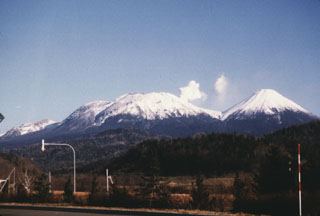Report on Akan (Japan) — October 2010
Bulletin of the Global Volcanism Network, vol. 35, no. 10 (October 2010)
Managing Editor: Richard Wunderman.
Edited by Edward A. Venzke.
Akan (Japan) November 2008 eruption followed by intermittent volcanic earthquake swarms in 2009
Please cite this report as:
Global Volcanism Program, 2010. Report on Akan (Japan) (Venzke, E.A., and Wunderman, R., eds.). Bulletin of the Global Volcanism Network, 35:10. Smithsonian Institution. https://doi.org/10.5479/si.GVP.BGVN201010-285070
Akan
Japan
43.384°N, 144.013°E; summit elev. 1499 m
All times are local (unless otherwise noted)
Eruptions are common at Akan, with recent eruptions in 1984, 1988, 1996, 1998, 2006, and 2008. Monthly observation reports from the Japan Meteorological Agency (JMA) after the 1998 eruption indicated that seismicity was persistent but often low over the following eight years, with earthquake swarms in 2002-2003. Although the eruptions in 2006 (BGVN 31:02) and 2008 (BGVN 33:10) were described previously, the detailed seismic data noted below were not.
Volcanic earthquake swarms were recorded during 18-23 January, 8 February, and 29-30 March 2002. Seismicity was high again during 1-11 January, 13-15 April, 19-20 August, 24-25 September, and 8-23 October 2003. No further episodes of increased seismicity were recorded until February 2006.
Two earthquake swarms in early 2006, on 18-19 February (more than 1,100 events) and 11 March (more than 600 events), preceded an eruption on 21 March. This small eruption from the NE flank of the Me-Akan cone on 21 March 2006 deposited ash on the snow 10 km SE of the summit (BGVN 31:02). Another volcanic earthquake swarm during 9-10 May 2006 consisted of over 900 events, but no ash plumes followed. Although seismicity was above background levels in January-February 2007, no distinct swarms were noted that year.
Elevated seismicity was again recorded on 10 January 2008, when 471 volcanic earthquakes were detected. A volcanic tremor event on 16 September preceded a seismic swarm during 26-30 September 2008 (with a high of 788 events on the 29th). Another tremor event on 29 September prompted JMA to raise the hazard status (BGVN 33:10).
Although seismicity dropped in early October 2008, 79 volcanic earthquakes were detected on 12 October, and activity was higher again during 19-27 October. An earthquake swarm during 9-12 November (high of 241 events on the 10th) was followed by 14 tremor events between 16 and 28 November. A single tremor event lasting 171 minutes on 17 November again prompted an Alert Level increase by JMA, and, the next day, S-flank ashfall was observed (BGVN 33:10). A grayish white ash plume rising above the crater on 28 November resulted in additional ashfall (BGVN 33:10).
Seismicity declined significantly after 17 December, before beginning a gradual increase on 5 January 2009. On 29 January 2009, there were 155 volcanic events, and a total of 1,785 for the month. Seismicity declined gradually during February-March, back to less than 100 events per month in April. Other than volcanic earthquake swarms on 8 July (357 events) and 6 September (358 events), seismicity remained low through the end of the year.
Geological Summary. Akan is a 13 x 24 km caldera located immediately SW of Kussharo caldera. The elongated, irregular outline of the caldera rim reflects its incremental formation during major explosive eruptions from the early to mid-Pleistocene. Growth of four post-caldera stratovolcanoes, three at the SW end of the caldera and the other at the NE side, has restricted the size of the caldera lake. Conical Oakandake was frequently active during the Holocene. The 1-km-wide Nakamachineshiri crater of Meakandake was formed during a major pumice-and-scoria eruption about 13,500 years ago. Within the Akan volcanic complex, only the Meakandake group, east of Lake Akan, has been historically active, producing mild phreatic eruptions since the beginning of the 19th century. Meakandake is composed of nine overlapping cones. The main cone of Meakandake proper has a triple crater at its summit. Historical eruptions at Meakandake have consisted of minor phreatic explosions, but four major magmatic eruptions including pyroclastic flows have occurred during the Holocene.
Information Contacts: Japan Meteorological Agency (JMA), Otemachi, 1-3-4, Chiyoda-ku Tokyo 100-8122, Japan (URL: http://www.jma.go.jp/).

